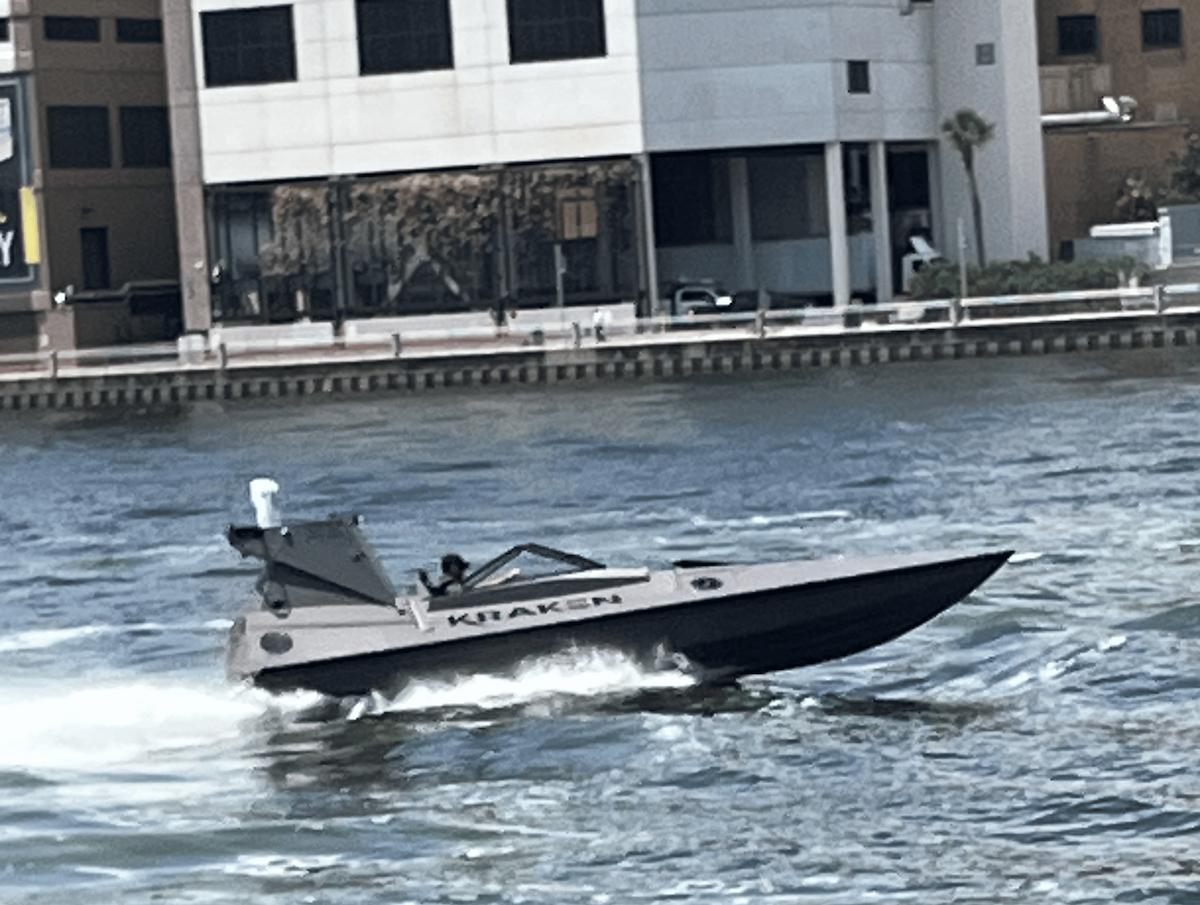When it comes to maritime autonomy, two names are making significant waves: the Kraken and the Devil Ray. These advanced autonomous surface vessels (ASVs) have redefined what’s possible for Special Operations Forces (SOF) and broader maritime missions. By delivering high performance and adaptability, both deliver a compelling return on investment (ROI) in some of the world’s most challenging environments.
Meet the Kraken: Modular Power and Stealth
The Kraken Group, a UK company founded in 2021, has collaborated with AV (the rebrand of blended companies AeroVironment and Blue Halo), to forge next-generation uncrewed surface vehicle (USV) platforms, the Kraken USV series.
The Kraken K3 Scout configuration, demonstrated at SOF Week 2025, measures 27 feet in length. This particular Kraken is purpose-built for speed, endurance and adaptability. It achieves surge speeds of up to 55 knots and boasts a range of 650 nautical miles, while its modular payload bay can accommodate up to 600 kilograms (over 1300 lbs). A modular open systems architecture (MOSA) underpins this flexibility, which allows for rapid integration of a wide array of sensors and effectors. If it fits the platform’s space, weight and power constraints, it can be deployed.
Autonomous By Design
Kraken Group’s extensive experience in offshore endurance racing informed the Kraken’s design and resulted in a vessel that combines speed and agility with robust survivability. With AV’s integrations, the Kraken supports multiple autonomy modes, from fully autonomous operation to remote and pilot-in-the-loop control, making it suitable for a diverse range of missions. AV’s collaborative autonomy ecosystem ensures that the Kraken is not just a standalone asset, but a node in a larger, integrated operational framework.
Modular and Open Architecture
The Kraken’s payload bay is truly sensor-agnostic. It can support rapid reconfiguration for missions ranging from electronic warfare (EW) to strike operations or advanced navigation. Notably, the Kraken integrates AV’s HaloNav system, a cutting-edge autonomous navigation solution for GPS-denied environments. HaloNav leverages sky polarization, solar and lunar tracking, celestial navigation, Inmarsat satellite positioning and inertial measurement units to achieve navigation accuracy within 100 meters globally – even in Anti-Access/Area Denial (A2AD) environments where GPS is unavailable or passive operations are required. Seamless integration occurs via standard navigation data outputs (such as NMEA 0183). Future development will enable collaborative positioning sharing among local uncrewed (UxS) platforms.
The Kraken also supports AV’s HaloSwarm technology, which enables coordinated operations with teams of UxS. HaloSwarm provides advanced AI/ML-driven swarm logic. This allows warfighters to conduct proxy operations with improved mission efficiency, enhanced sensor performance and reduced cognitive workload. This capability significantly multiplies the operational impact of the Kraken, especially when deployed in concert with other USVs, uncrewed underwater vehicles (UUVs), or small uncrewed aircraft systems (sUAS).
Integrated Mission Payloads
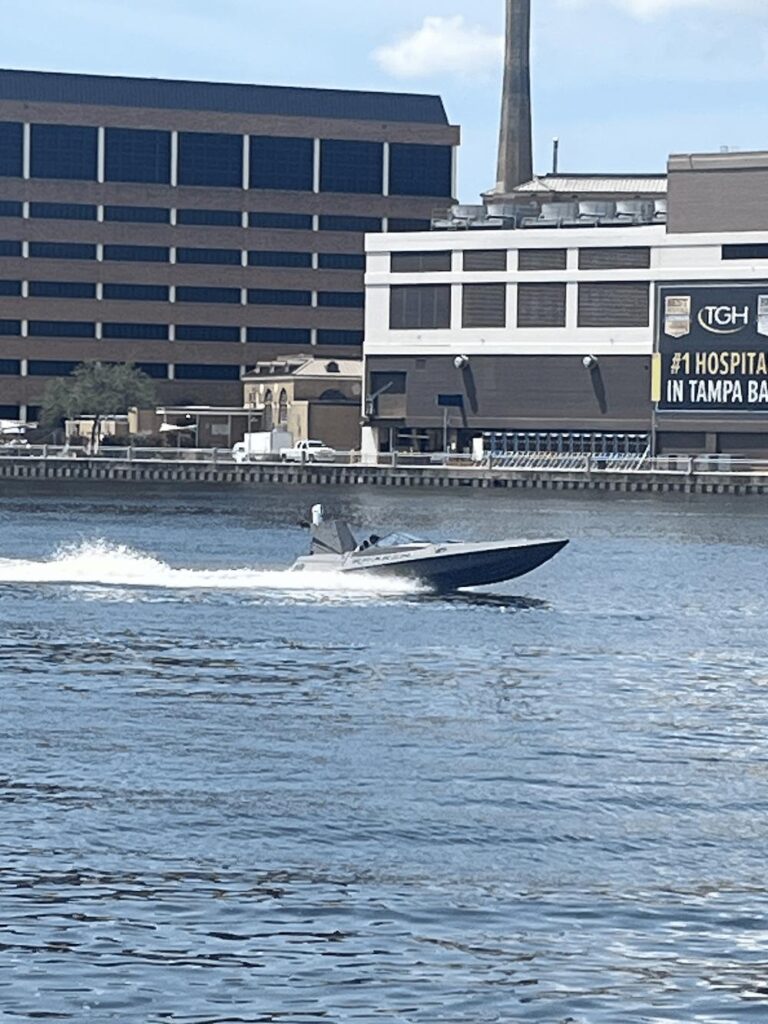
AV’s collaborative approach extends to payload integration, with the Kraken capable of hosting a wide range of mission systems. These include AV’s own sUAS platforms (such as IE-V2, IE-V3, E900 and E1250) for expanded mission reach, the Titan-SV for 360-degree surveillance and sUAS threat detection, and the Titan C-UAS™ system for countering drone threats. Additionally, AV’s open-architecture EW chassis and software-defined radios provide actionable intelligence, surveillance and reconnaissance (ISR) capabilities at the tactical edge.
Scalable Family
The Kraken family is highly scalable, ranging from compact 20-foot models to a formidable 60-foot variant capable of carrying 10,000 kg (more than 22,000 lbs) across 2,000 nautical miles. The largest Kraken can transport a 20-foot shipping container, which makes it ideal for contested resupply missions and a wide range of other operational scenarios.
With AV’s collaborative autonomy ecosystem, advanced navigation, and integrated multi-mission payloads, the Kraken represents a leap forward in modular, scalable, and intelligent maritime operations. In short, AV has worked alongside Kraken to integrate other payloads and systems on USV and UUV platforms for next-level fully autonomous multi-mission operations.
Enter the Devil Ray: High-Performance Autonomy for SOF
They say the devil is in the details. For Maritime Tactical Systems, Inc. (MARTAC), its devil was on full display in Tampa Bay. MARTAC’s Devil Ray (T38 variant) also stood out in the autonomous vessel arena.
Built for Speed
Measuring 38 feet in length and 11 feet in width, the Devil Ray T38 is powered by twin inboard/outboard engines, available in diesel or gas configurations. The company engineered it for both endurance and high-speed performance.
The vessel is capable of astonishing burst speeds of 70 to 100+ knots, with a maximum payload capacity of up to 4,500 pounds, making it one of the fastest and most versatile USVs in its class.
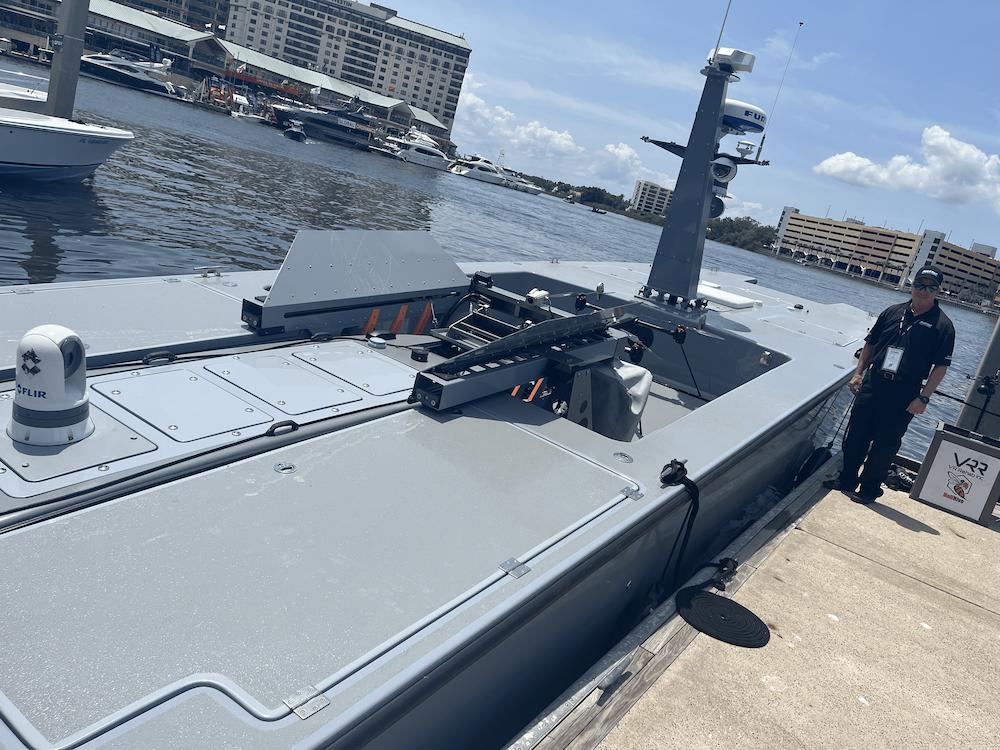
Proven Performance
MARTAC’s autonomy suite is homegrown and specifically tailored to the Devil Ray’s high-performance characteristics. The vessel has accumulated over 10,000 operational hours across 20 countries. It has demonstrated robust reliability even in complex, high-threat environments.
Notably, the Devil Ray T38 completed a fully autonomous international run across the Florida Straits to the Bahamas in under one hour, achieving a top speed of 71.5 knots and averaging 61 knots over a 61-mile course. This industry first underscores the vessel’s operational maturity and technical readiness.
The T38 is certified at Technical Readiness Level Nine (TRL 9). It floats at the ready for immediate deployment and integration into naval fleets without special accommodations, as it matches the size of the standard 11-meter Rigid Hull Inflatable Boat (RHIB) carried by many U.S. Navy ships.
Devil Ray As Mothership
The Devil Ray T38 features another unique capability: it can deploy a smaller vessel off its stern. Specifically, the Devil Ray T38 is equipped with a stern ramp and an advanced Autonomous Launch & Recovery System (ALARS) that enables it to autonomously launch and recover smaller unmanned surface vessels, specifically the MANTAS T8 (2.5 meters) and T12 (3.6 meters, or approximately 12 feet) USVs, while underway.
This integration enables the Devil Ray to serve as a mothership, extending its operational reach by deploying the smaller, agile MANTAS vessel for missions such as reconnaissance, surveillance, or other tasks requiring a lower profile or access to constrained environments. The ability to launch and recover a USV while moving at sea enhances mission flexibility and supports complex, multi-domain operations.
Use Cases: SOF and Beyond
The Devil Ray’s operational versatility is likewise remarkable. SOF units have already leveraged the vessel for:
- Ingress, egress, and extraction operations
- Medical evacuation (medevac) missions, including rapid retrieval of injured personnel
- Search and rescue, such as locating downed pilots in hostile waters
- Support for kinetic and non-kinetic missions, including weaponized payloads
Recent live-fire exercises have demonstrated the T38’s ability to launch lethal miniature aerial missile systems that have successfully engaged targets at sea under remote human supervision. This integration of uncrewed and AI-driven capabilities allows the Devil Ray to operate seamlessly alongside manned vessels to support both defensive and offensive maritime operations.
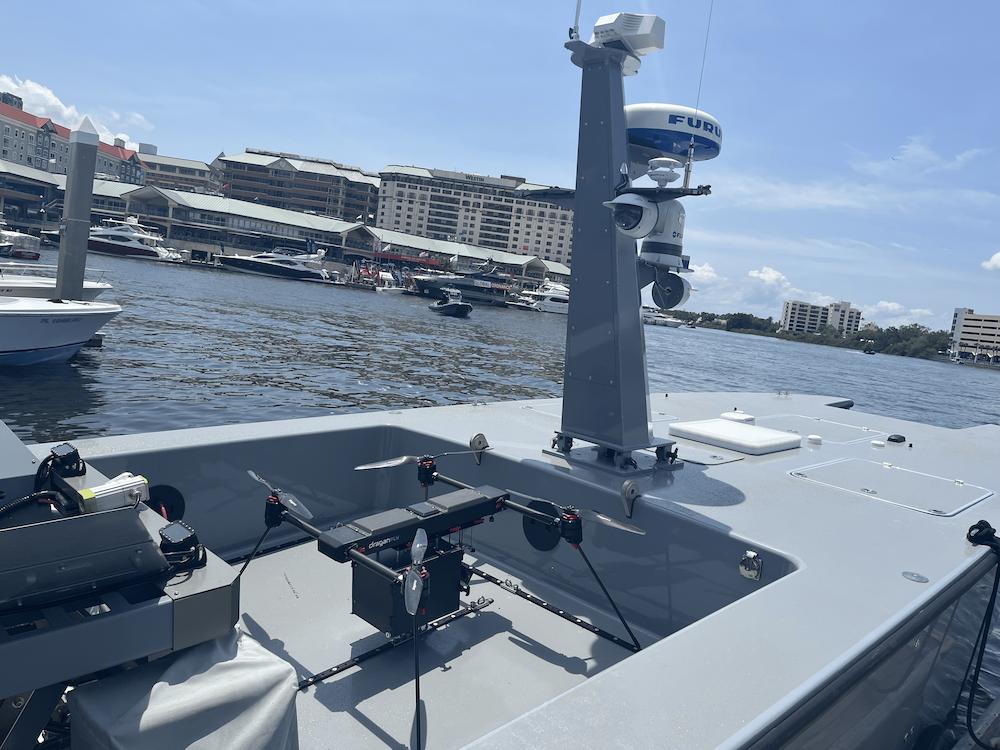
Its adaptability has been field-tested with over 100 real-world use cases executed and 300 more identified. These span a wide array of defense missions such as ISR swarm, EW, mine countermeasures, anti-submarine warfare and high-value escort. It can also support commercial roles like environmental monitoring and port security.
With its ability to operate in adverse sea states, execute swarm tactics, maintain high reliability and deliver unmatched speed and payload flexibility, the MARTAC Devil Ray T38 seems ideal for both SOF and a broad spectrum of maritime operators.
ROI for Autonomy in Maritime SOF Operations
Advances in these types of autonomous maritime platforms deliver unprecedented ROI for SOF by fundamentally reshaping the risk calculus and operational potential of maritime missions. Because they remove crews from direct exposure to hostile environments and leverage the precision and persistence of uncrewed vessels, SOF units gain critical advantages in force protection, operational reach, mission flexibility and cost efficiency.
Autonomous systems not only reduce the risks of human error – which accounts for up to 96% of maritime accidents – but also enable continuous operations, rapid reconfiguration for diverse mission sets and substantial savings in crew-related expenses.
As these technologies continue to mature and prove their reliability in real-world deployments, they stand poised to become indispensable assets that extend the reach and effectiveness of SOF while safeguarding the lives of operators on the front lines.
Force Protection: Saving Lives
The most immediate and profound ROI for autonomous USVs centers on the preservation of human life. Autonomous vessels like the Kraken and Devil Ray remove personnel from direct exposure to hostile environments, mines and other maritime threats. During an onsite interview at SOF Week, Bruce Hansen, CEO of MARTAC emphasized his company’s goal:, “The number one thing is there’s no loss of life. That was our mission from day one. Keep people out of harm’s way whenever possible.”
Operational Reach and Persistence
Autonomous vessels also dramatically extend operational reach. With ranges up to 2,000 nautical miles and the ability to operate at high speeds or loiter for extended periods, these platforms enable persistent surveillance, rapid response and deep penetration into contested areas-without fatigue or risk to crews.
Mission Flexibility and Customization
Both Kraken and Devil Ray are designed for rapid reconfiguration. Their modular architectures allow SOF units to tailor payloads and mission profiles on the fly, supporting everything from EW to logistics and direct action. This flexibility reduces the need for multiple specialized platforms. It also streamlines both logistics and training.
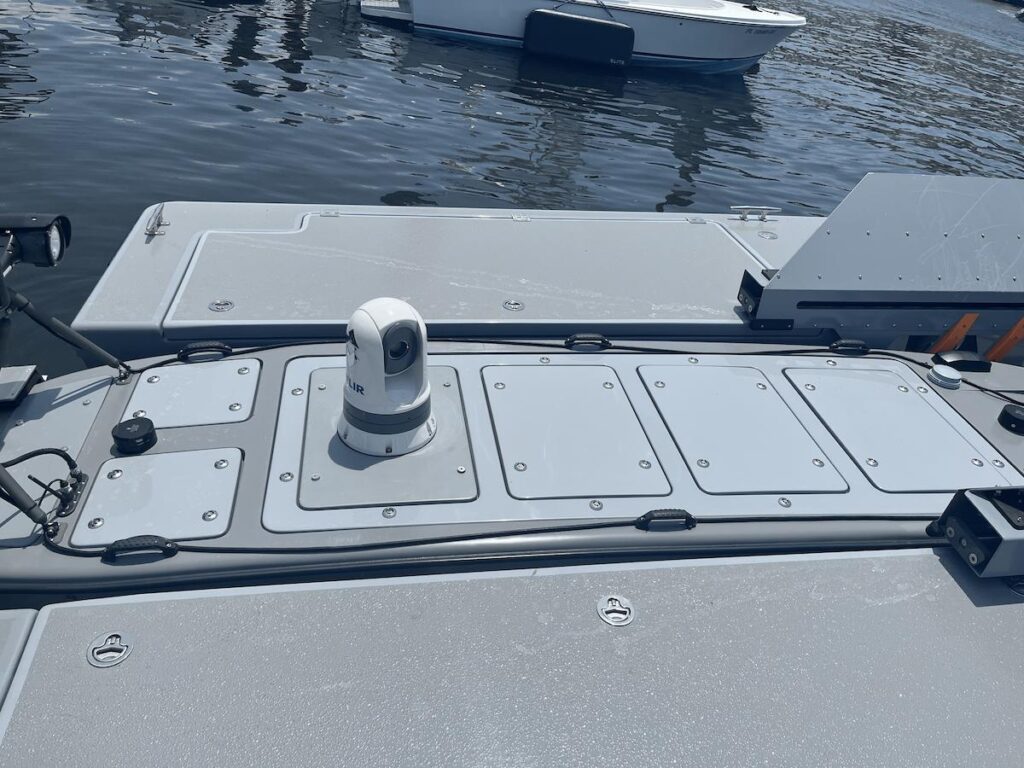
Cost Efficiency
Autonomous platforms reduce the long-term costs associated with training, sustaining and protecting human crews. Maintenance cycles are optimized for uncrewed operations, to mitigate the risk of catastrophic loss (both human and material). Additionally, the ability to operate in swarms or teams multiplies force presence without multiplying personnel costs.
Reliability and Availability
With thousands of operational hours and proven reliability, platforms like the Devil Ray are ready for large-scale deployment today. Their availability and robust performance in diverse environments means that SOF can depend on these assets for critical missions, reduce downtime and increase mission success rates.
The Future Is Now: Swarming, Integration and Human-Machine Teaming
Both Kraken and Devil Ray have the ability to operate in swarms and coordinate actions across multiple domains. This heralds a new phase of maritime operations where human operators can direct complex missions from a distance and focus on decision-making, rather than direct control.
The open architectures of these platforms ensure that as new sensors, effectors and AI capabilities emerge, they can be rapidly integrated. This essentially future-proofs investments through continued operational relevance.
Release the Kraken and Devil Ray
As SOF maritime missions become more complex and high-stakes, the need for autonomous, adaptable and resilient platforms has never been greater. The Kraken and Devil Ray exemplify the best of this new generation: high-speed, long-range, modular and truly autonomous. Their proven performance, mission flexibility and life-saving potential drive a compelling ROI and make them indispensable assets for modern maritime operations. For SOF and maritime forces looking to stay ahead of the curve, now is the time to release the Kraken and the Devil Ray!
Kraken Specifications at a Glance
- Length: 27 feet (K3 Scout variant)
- Top Speed: 55 knots
- Range: 650 nautical miles
- Payload Capacity: 600 kg (modular bay)
- Engine: Inboard common rail diesel (low acoustic, radar, and electromagnetic signatures)
- Construction: All-composite for low visual and radar signature
- Sea State Performance: 30 knots in sea state 4, survivable up to sea state 5-6
Devil Ray TI 38 Specifications
- Length: 38 feet
- Beam: 11 feet
- Engines: Twin diesels
- Range:
- 2,000 miles at slow cruise
- 1,000 miles at 25–32 knots
- 700 miles at 60–65 knots
- Autonomy: True Level 4, full collision avoidance, COLREGs compliant
- Swarm Capability: Multiple vessels can operate in coordinated swarms
Kraken and Devil Ray Capabilities
| Feature | Kraken K3 Scout | Devil Ray TI 38 |
| Length | 27 ft (K3 Scout) | 38 ft |
| Top Speed | 55 knots | 60–65 knots |
| Range | 650 nm (K3 Scout) | 2,000 nm (slow), 1,000 nm (cruise) |
| Payload Capacity | 600 kg (modular bay) | Not specified, but high |
| Autonomy | Modular, open architecture | True Level 4, full collision avoid |
| Swarm Capability | Yes (Blue Halo integration) | Yes |
| Sea State Performance | 30 knots in sea state 4; | Operates in high sea states |
| survivable up to 5–6 | ||
| Signature | Low acoustic, radar, visual | Not specified |
| Use Cases | Strike, EW, logistics, ISR | SOF ingress/egress, medevac, SAR |

